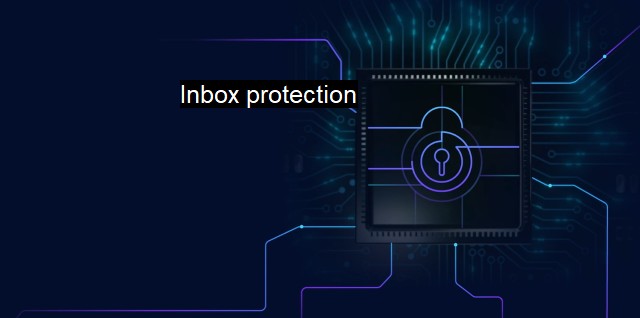What is Inbox protection?
Stay Safe from Cyber Attacks: The Importance of Inbox Protection in Today's Digital Landscape
Inbox protection refers to the methodology employed to safeguard email accounts from potential threats such as phishing links, malware, and spam. it plays an instrumental role in preventing unwarranted access to personal or sensitive data. This is especially pertinent given that malicious individuals, by exploiting various email-based vulnerabilities, are constantly evolving in their sophistication.To better grasp the concept of inbox protection, it's necessary to highlight the potential threats that warrant its need. At the top of the list is phishing – deceptive communications intended to extract sensitive data such as usernames, passwords, and financial information. Disguising their malicious intent, cybercriminals often mimic trusted entities, thereby baiting unsuspecting victims into disclosing sensitive information. Given that over 90% of all cyberattacks commence with a phishing email, the importance of inbox protection cannot be overstated.
Apart from phishing, cybercriminals resort to malware to inflict damage. Emails serve as potent malware vectors, with cybercriminals leveraging disguised links or seemingly innocuous attachments to distribute their payloads. Upon accessing these links or files, the malware infiltrates the system, undertaking a range of damaging operations, including holding data hostage or stealing confidential information.
Another significant threat is spam, and while such emails are often viewed as mere inconveniences, this perception overlooks their potential harm. Spam messages can cover a broad spectrum, from unsolicited advertisements to outright harmful content. Left unchecked, these mass-generated emails can clog an inbox, obscure legitimate messages, and even come outfitted with malware.
Inbox protection, therefore, necessitates a multi-dimensional approach to offset these diverse threats. The first line of defense constitutes spam filters that detectors and quarantine unexpected emails, substantially reducing the likelihood of clicking on malicious emails. Further, antivirus software builds upon this foundation by scanning new emails and attachments for known patterns identified as hazardous. Once a threat is detected, the software intercepts the payload, prevents it from infiltrating your system, and notifies you of the risk.
Inbox protection extends to include email authentication techniques, such as Sender Policy Framework (SPF) and Domain Keys Identified Mail (DKIM). These techniques seek to verify the sender's identity, thereby inhibiting unauthorized use while simultaneously aiding the identification of potential fraudulent activities.
Encryption, too, plays an essential role within inbox protection. Here, data transmitted through emails are coded, preventing unauthorized access in case the transmission falls into the wrong hands. Paired with advanced Secure Sockets Layer (SSL) or Transport Layer Security (TLS), encryption adds an extra layer of protection, bolstering security during transmittance.
Lastly, employee training plays a crucial part in optimizing inbox protection. Since humans are often the susceptible elements within an email system, it becomes crucial to educate oneself on how to spot phishing attempts, suspicious links, and malware-infused attachments. Institutions should ideally institute ongoing cybersecurity awareness training to better prepare their employees for potential threats.
Inbox protection forms the bedrock of any solid cybersecurity and antivirus strategy. Given how pivotal emails are in our everyday digital exchanges – for businesses and individuals – prioritizing inbox protection must not be secondary. Indeed, against the backdrop of increasingly sophisticated cyber threats, a meticulous approach to inbox protection is vital in fortifying ourselves against the growing onslaught of cyber crime.

Inbox protection FAQs
What is inbox protection and why is it important in cybersecurity?
Inbox protection refers to the measures taken to secure email inboxes from cyber threats. Email is often used as a vehicle for malware, phishing attacks, and other cyber threats. As such, inbox protection is critical in preventing cybercriminals from gaining unauthorized access to sensitive information or causing damage to IT systems.What are some common inbox protection technologies used in cybersecurity?
Common inbox protection technologies include spam filters, antivirus software, and firewalls. Spam filters help to identify and block unsolicited or unwanted email messages. Antivirus software scans email attachments and links for malware or viruses. Firewalls help to prevent unauthorized access to email servers and IT systems.What are some best practices for inbox protection?
Some best practices for inbox protection include using strong passwords, enabling two-factor authentication, avoiding clicking on suspicious email links, regularly updating antivirus software, and being cautious of emails that request personal or sensitive information. It is also important to keep an eye out for phishing emails, which often attempt to trick recipients into revealing confidential information.How can businesses ensure that their employees are trained on inbox protection best practices?
Businesses can provide regular cybersecurity training sessions for employees that cover inbox protection and related topics. These training sessions can be delivered in-person or online and should cover topics such as identifying phishing emails, creating strong passwords, and avoiding email scams. It is also important to have clear guidelines and policies in place for secure email usage, and to regularly remind employees of these policies.| | A | | | B | | | C | | | D | | | E | | | F | | | G | | | H | | | I | | | J | | | K | | | L | | | M | |
| | N | | | O | | | P | | | Q | | | R | | | S | | | T | | | U | | | V | | | W | | | X | | | Y | | | Z | |
| | 1 | | | 2 | | | 3 | | | 4 | | | 7 | | | 8 | | |||||||